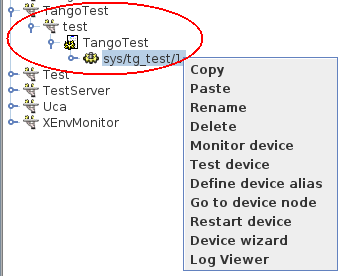Linux
Intended audience: administrators, developers
Debian + Ubuntu
Non-interactive installation
Install packages required to compile tango-controls:
sudo apt-get install g++ openjdk-8-jdk mariadb-server libmariadb-dev zlib1g-dev libomniorb4-dev libcos4-dev omniidl libzmq3-dev make
Start mariadb :
sudo service mariadb start
Set password for mariabdb root user to ‘mypassword’ (change as appropriate):
sudo mariadb -u root
ALTER USER 'root'@'localhost' IDENTIFIED BY 'mypassword';
# The following 2 lines do not apply on recent mariadb versions (MariaDB-10.4+)
# Please refer to MariaDB documentation to configure correctly your users (https://mariadb.com/kb/en/alter-user/ and https://mariadb.com/kb/en/set-password/)
UPDATE mysql.user SET authentication_string = '' WHERE user = 'root';
UPDATE mysql.user SET plugin = '' WHERE user = 'root';
Download source tarball from github:
wget https://gitlab.com/api/v4/projects/24125890/packages/generic/TangoSourceDistribution/9.3.5/tango-9.3.5.tar.gz
Unpack in a sub-directory called tango:
mkdir tango
cd tango
tar xzvf tango-9.3.5.tar.gz
Configure tango-controls to build and install in /usr/local/tango (set the DB password as appropriate):
./configure --enable-java=yes --enable-mariadb=yes --enable-dbserver=yes --enable-dbcreate=yes --with-mysql-admin=root --with-mysql-admin-passwd='mypassword' --prefix=/usr/local/tango
Compile tango-controls:
make
Install tango-controls:
sudo make install
Add following lines to start script /usr/local/tango/bin/tango:
sudo gedit /usr/local/tango/bin/tango
# add lines near the top:
export MYSQL_USER=root
export MYSQL_PASSWORD=mypassword
Start tango-controls database server:
sudo /usr/local/tango/bin/tango start
Set the TANGO_HOST variable (note: you can do this in e.g.
~/.bashrcor wherever it is appropriate for your system):
export TANGO_HOST=localhost:10000
Start test device server:
/usr/local/tango/bin/TangoTest test &
Test Jive:
/usr/local/tango/bin/jive &
You can now define your device servers and devices, start and test them!
CentOS
RPM packages for RedHat based systems are built from the tango-spec repository using Copr. Copr can be used as a repository but only the latest build is kept forever. To install the packages directly from Copr, please refer to the tango-spec README.
RPM packages from Copr are also available in the MAX-IV’s repository. Use yum to install them e.g. to install the TANGO database and test device server:
$> sudo yum install -y mariadb mariadb-server
sudo yum install -y libtango9 tango-db tango-test
The above packages install the Tango core C++ libraries, database and TangoTest server.
Installation
If you want to install TANGO on CentOS, here are the steps you should follow:
add the EPEL repository:
$> sudo yum install -y epel-release
add the MAX-IV’s public repository by creating the following file:
$> sudo nano /etc/yum.repos.d/maxiv.repo
[maxiv-public]
name=MAX IV public RPM Packages - $basearch
baseurl=http://pubrepo.maxiv.lu.se/rpm/el$releasever/$basearch
gpgcheck=0
enabled=1
$> sudo yum makecache
install and start MariaDB:
$> sudo yum install -y mariadb-server mariadb
sudo systemctl start mariadb
sudo systemctl enable mariadb
run mysql_secure_installation script:
$> sudo mysql_secure_installation
install TANGO library:
$> sudo yum install -y libtango9 libtango9-devel
install tango-db and tango-common packages:
$> sudo yum install -y tango-db tango-common
create TANGO database:
$> cd /usr/share/tango-db/
sudo ./create_db.sh
set up TANGO environment:
Note
You should not use localhost as your TANGO_HOST. You can set the machine hostname using sudo hostnamectl set-hostname tangobox
$> sudo nano /etc/tangorc
For example:
TANGO_HOST=tangobox:10000
set up environment variables:
$> sudo nano /etc/profile.d/tango.sh
For example:
. /etc/tangorc
export TANGO_HOST
start and enable TANGO database:
$> sudo systemctl start tango-db
sudo systemctl enable tango-db
install Starter and TangoTest:
$> sudo yum install -y tango-starter tango-test
start and enable Starter:
$> sudo systemctl start tango-starter
sudo systemctl enable tango-starter
install Java based tools:
$> sudo yum install -y tango-java
install PyTango:
$> sudo yum install -y python-pytango
Arch
An AUR package exists here
Download and install it from there, or use your favourite AUR helper application to do the work for you.
Video
The following video (by Mohamed Cherif Areour, in French with English subtitles) shows you how to install Tango on Ubuntu and LinuxMint.
Testing
How to test that everything was correctly installed
You have to have “tango-test” been installed and check where is it located (you can use “locate TangoTest” command) and start it with “test” instance.
For example:
$> /usr/lib/tango/TangoTest test
Console should display “Ready to accept request”.
After you may go to Jive and choose the following window (see the image below):

TangoTest (it is a server)-> test (it is an instance) -> TangoTest (it is a class) -> sys/tg-test/1 (it is a device)
Right click on the device and choose “Test device”.
You should get a new window with “Attributes” where you should see the values. That means you have done everything correct.